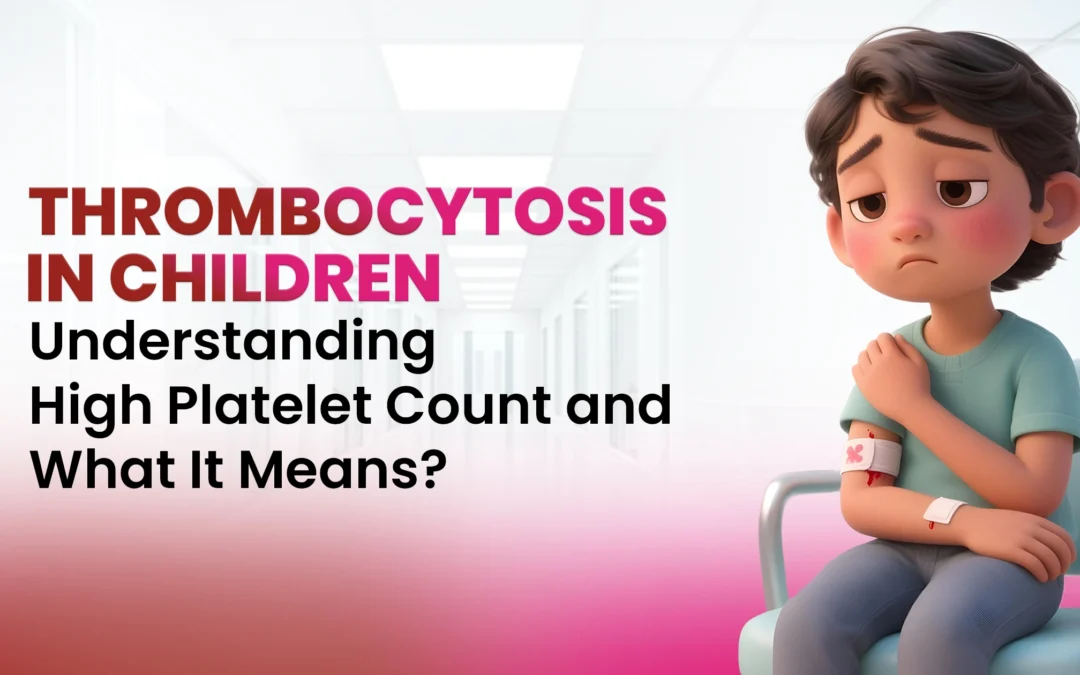Parents are often surprised when a routine blood test shows that their child’s platelet count is “high.” The first question they ask is — “Doctor, is this dangerous?”
A condition known as Thrombocytosis occurs when the platelet count is higher than normal. While it can sound concerning, in most cases, it is a temporary and harmless response to another condition such as infection, inflammation, or iron deficiency.
As a Pediatric Hematologist, I’ll explain in this blog what thrombocytosis means, why it happens, and when parents should take it seriously.
1. What Is Thrombocytosis?
Platelets are tiny cell fragments in the blood responsible for forming clots and stopping bleeding.
- Normal platelet count in children: 150,000 to 450,000 per microliter of blood
- Thrombocytosis: Platelet count above 450,000
- Severe Thrombocytosis: Platelet count exceeding 1,000,000
Thrombocytosis is more common in children than most people realize — and it is usually reactive (secondary) rather than a primary blood disorder.

2. Types of Thrombocytosis
1. Reactive (Secondary) Thrombocytosis
- The most common type seen in children.
- Platelet levels rise in response to another condition such as infection, inflammation, or injury.
- Usually temporary and resolves once the underlying cause is treated.
2. Primary (Essential) Thrombocytosis
- Very rare in children.
- Caused by an abnormality in the bone marrow where platelets are produced excessively.
- Needs specialized evaluation and monitoring.
3. Common Causes of High Platelet Count in Children
Infections:
- Bacterial or viral infections can temporarily increase platelet production as part of the body’s immune response.
Inflammatory Conditions:
- Diseases like juvenile arthritis or inflammatory bowel disease can cause sustained elevation.
Iron Deficiency Anemia:
- Surprisingly, low iron levels can trigger the body to make more platelets.
Post-Surgery or Injury:
- Bone marrow may react by producing excess platelets during recovery.
Bone Marrow Disorders (Rare):
- Essential thrombocythemia or myeloproliferative disorders lead to uncontrolled platelet production.
4. Symptoms of Thrombocytosis in Children
In most cases, thrombocytosis causes no symptoms and is found incidentally during a routine blood test.
However, if the platelet count becomes excessively high, the following symptoms may occur:
- Headache or dizziness
- Tingling or numbness in hands and feet
- Unusual redness in palms and soles
- Easy bruising or minor nosebleeds
Rarely, clotting-related complications (extremely rare in children)
5. How Is Thrombocytosis Diagnosed?
Diagnosis begins with a Complete Blood Count (CBC) that shows high platelet count.
Further investigations may include:
- Peripheral Smear – to confirm platelet morphology
- Iron Studies – to detect iron deficiency
- Inflammatory Markers (CRP, ESR) – to check for infection or inflammation
- Bone Marrow Examination – in cases of unexplained or persistent thrombocytosis
- Genetic Tests (if needed) – for rare bone marrow disorders
6. Treatment of Thrombocytosis
Most cases do not require any specific treatment. The focus is always on treating the underlying cause.
✅ For Reactive Thrombocytosis:
- If caused by infection → treat infection.
- If due to iron deficiency → start iron supplementation.
- Platelet count usually normalizes within weeks.
✅ For Primary Thrombocytosis:
- Requires ongoing monitoring by a Pediatric Hematologist.
- In rare cases, medications may be used to prevent clotting if counts remain very high.
- Platelet-lowering medicines are rarely needed in children.
7. When Should Parents Be Concerned?
Seek consultation if:
- Platelet count remains elevated for more than a month.
- The child has recurring headaches, weakness, or bleeding.
- There is a family history of blood disorders.
Prompt evaluation ensures that any serious causes are ruled out early.
8. Long-Term Outlook
Most children with thrombocytosis have a completely normal prognosis. Once the underlying trigger is treated, platelet counts return to normal.
Only a very small percentage have primary bone marrow–related causes that require continuous care.
Conclusion

Thrombocytosis is a condition that often looks alarming on paper but is usually the body’s natural response to another event.
With the right evaluation by a specialized Pediatric Hematologist, parents can be reassured, guided, and treated appropriately — ensuring the child’s complete health and safety.
If your child’s platelet count is persistently high, consult a Pediatric Hemato-Oncologist for a thorough evaluation and expert guidance.

